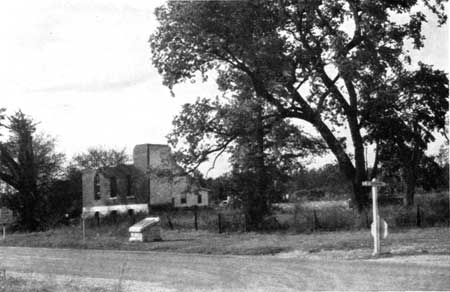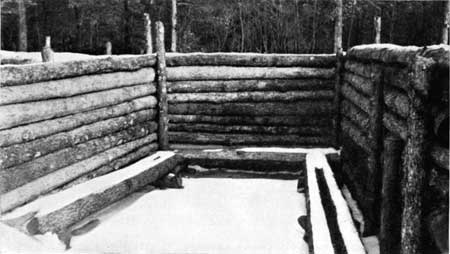MENU
|
Glimpses of Historical Areas East of the Mississippi River |
|
The War Between the States |
|
VIRGINIA |
Special Features: Six great battlefields of the War Between the States, in the vicinity of Fredericksburg, containing miles of original trenches and earthworks and a fine museum.

Ruins of the Chancellor House.
(Photo by Rinehart)
THE Fredericksburg and Spotsylvania County Battlefields Memorial National Military Park presents to the visitor the closely connected fields of six of the greatest and most important battles of the War Between the States, namely, the two battles of Fredericksburg, Chancellorsville, Salem Church, the Wilderness, and Spotsylvania Courthouse. The town of Fredericksburg, the natural starting point for a visit to all of these fields, also contains many landmarks which are testimony to the importance of the place in the colonial and early national periods. Located at the fall line on the Rappahannock River, it was destined to play a major role in our history. In 1861-65 its position midway between the Federal and Confederate capitals made it the hub of the eastern theater of war.
In the tremendous battles fought near Fredericksburg can be traced the ebb and flow of the fortunes of the Confederacy. Here, in 1862-63, the Army of Northern Virginia, at the height of its power, defeated the Army of the Potomac and marched to invade the North. Here, in 1864, the same Army of Northern Virginia, with waning strength, its back to the wall, resisted with desperate valor the raining blows of its old foe, now commanded by U. S. Grant, a leader of different mettle from his predecessors. The records of these conflicts are written indelibly in the terrain of the park. In the ridges and valleys and the open plains and woodlands are still to be seen the infantry entrenchments and gun pits dug by the men who strove mightily upon this ground.
The First Battle of Fredericksburg. — In the spring of 1862, McClellan, ascending the peninsula between the York and the James Rivers, had attempted to take Richmond and failed. Lee's northward march followed, marked by the battles of Second Manassas and Antietam. In November McClellan was replaced in command of the Army of the Potomac by Burnside, who undertook to advance on Richmond through Fredericksburg. Lee, on the heights behind Fredericksburg, blocked his path with 91,000 men, Stonewall Jackson's corps on the right, Longstreet on the left. The Army of the Potomac crossed the Rappahannock on pontoon bridges on December 11 and 12. On the morning of December 13 Franklin's Left Grand Division attacked the Confederate right near Hamilton's Crossing, while Sumner's Right Grand Division was hurled against Longstreet's front at Marye's Heights just west of Fredericksburg. But the heroic assaults of Meade's and Gibbon's Union divisions near Hamilton's Crossing, and of 18 brigades at Marye's Heights, all were repulsed. By nightfall the Federal army had sustained 13,000 casualties and the Confederate more than 5,000. For two more days the Federal army held its position in town and along the river. On December 15 and 16 they recrossed the river.
The Chancellorsville Campaign. — Through the winter the antagonists faced one another across the Rappahannock. After again changing commanders, the Army of the Potomac under Maj. Gen. Joseph Hooker was reorganized, and at the end of April 1863 crossed the Rappahannock at Kelly's Ford and marched around Lee's left flank to attack him from the rear, hoping thus to clear the road to Richmond. Sedgwick's Corps was left before Fredericksburg to engage the Confederates on that front. Compelled thus to divide his army, Lee left Early's division to face Sedgwick, while on May 1 Jackson's corps and Anderson's and McLaw's divisions marched toward Chancellorsville, where Hooker was encamped. The brilliant plan of the Federal commander had been well executed thus far. But instead of boldly attacking the outnumbered Confederates, he remained in his entrenchments and awaited attack.
Discovering that Hooker's right flank lay unprotected on the Orange Turnpike about 2 miles west of Chancellorsville, Lee now sent Jackson's corps on a circuitous march through the Wilderness to fall upon it from the west. About sunrise, May 2, 1863, Jackson started on one of the most audacious flank movements in military history. At about 6 o'clock that evening Howard's Corps, the right wing of Hooker's army, was surprised and shattered by Jackson's troops charging furiously out of the forest. Only the fall of darkness, coupled with the mortal wounding of Jackson, put a limit to the exploitation of the Confederate victory. But on May 3 Hooker was driven back to his entrenchments, previously prepared, to cover his line of retreat. That afternoon Lee was compelled to send McLaws and later Anderson to oppose Sedgwick, who had driven Early from Fredericksburg and was advancing west along the Orange Plank Road. At Salem Church Sedgwick was repulsed and on the night of May 4 withdrew across the Rappahannock at Banks Ford, while the main body of the Army of the Potomac recrossed at United States Ford during the following night. Thus ended the Chancellorsville campaign. The approximate Federal losses were 17,000; the Confederate, 13,000.
The Army of Northern Virginia now assumed the offensive in an invasion of Pennsylvania which reached its climax at Gettysburg, the turning point of the war in the East.
The Battle of the Wilderness. — The armies did not again grapple in earnest until the following spring, when the Federals, under Grant's firm leadership, having crossed the Rapidan with the purpose of passing Lee's army and pressing on to Richmond, were fiercely attacked on May 5, 1864, by the Confederates in the Wilderness. Advancing from Orange Courthouse, Lee had Ewell's Corps on the left along the Orange Turnpike, and A. P. Hill's on the right, along the Plank Road. Ewell struck Warren's Corps, while Hancock's struggled against Hill, Sedgwick aiding both the Federal corps. The day of desperate fighting ended indecisively, and the battle was resumed at sunrise next morning. The Federals had been reenforced by Burnside's Corps, and the Confederates by Longstreet's, the latter coming to the aid of Hill. Everywhere fierce attacks and counter attacks swept through the tangled Wilderness, which in many places caught fire, cremating the helpless wounded. Again darkness fell on an inferno in which neither side yet held a decided advantage.

Trench Restoration, Fredericksburg
Battlefield.
Battle of Spotsylvania Courthouse. — On the evening of May 7, the Army of the Potomac moved, not in retreat, but down the Brock Road toward Richmond. Grant's decision to capitalize his preponderance of numbers by driving ahead was perhaps the most momentous one of the whole war. Nevertheless, Lee quickly detected his move, and when the Federals, with Warren's V Corps leading, approached Spotsylvania Courthouse they found Longstreet's Corps, now under Anderson, across their path. The entire forces of both armies eventually were brought up, and again the battle was waged on a tremendous scale. The Confederates entrenched in the form of a great horseshoe around Spotsylvania Courthouse, and two weeks passed while the Federals vainly assailed them at various points. The bitterest fighting occurred on May 10 and 12 when Wright's and Hancock's corps penetrated Lee's line at the apex of the salient, where the hand-to-hand conflict was so sanguinary that the sector became famed as the Bloody Angle. Though unable to break through, Grant, on May 20, again moved his troops "by the left" toward Richmond. In the Wilderness and at Spotsylvania the Army of the Potomac had suffered losses of about 33,000 men, while Lee had lost perhaps 20,000.
The National Military Park. — The 2,439 acres of the Fredericksburg and Spotsylvania County Battlefields Memorial National Military Park contain the most important portions of the ground on which the above mentioned battles were fought. The lines of the time-worn earthworks still stand in the forest, witnesses to the grim struggles which raged on the five fields. Roads have been constructed beside them and to the key points of the terrain and there are sample restorations of field fortifications. Ranger historians are on duty at contact stations in the field and at park headquarters in Fredericksburg to aid the visitor in visualizing the memorable events which took place on this historic ground.
NEXT> Gettysburg National Military Park
 Top
Top
Last Modified: Thurs, Nov 23 2000 10:00:00 pm PDT
http://www.cr.nps.gov/history/online_books/glimpses3/glimpses4m.htm
![]()
